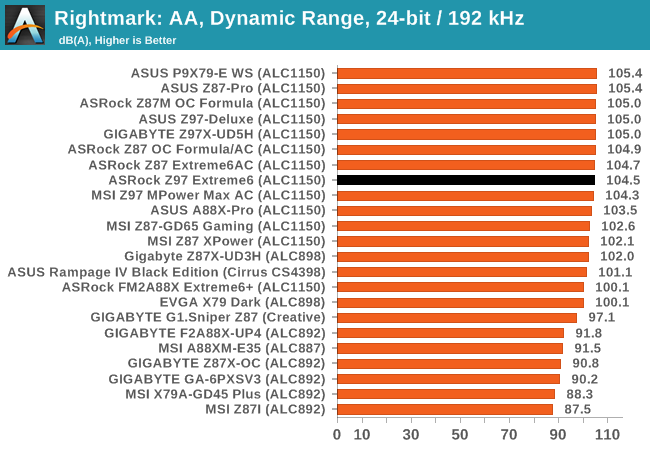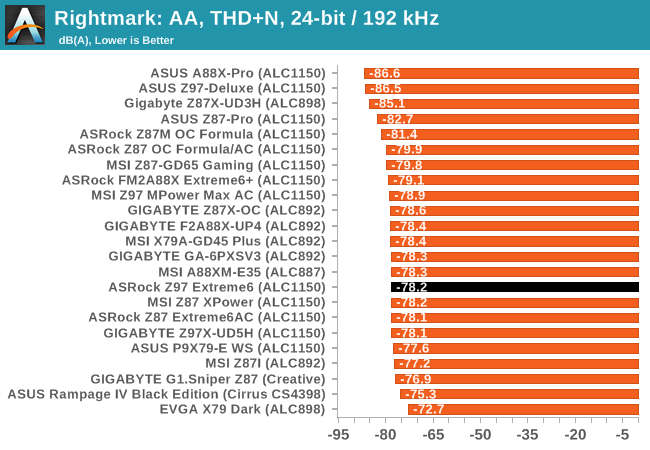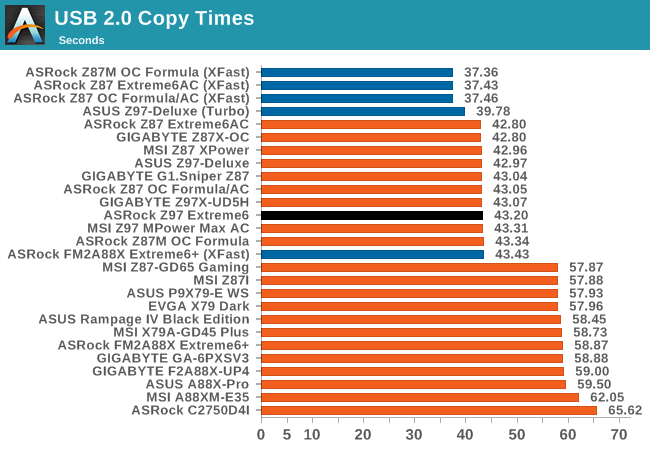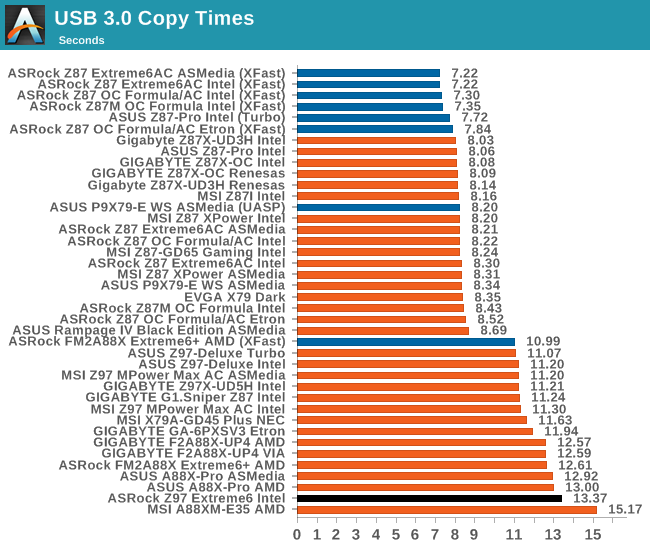ASRock Z97 Extreme6 Review: Ultra M.2 x4 Tested With XP941
by Ian Cutress on May 24, 2014 12:00 PM ESTSystem Benchmarks
Rightmark Audio Analyzer 6.2.5
The premise behind Rightmark:AA is to test the input and output of the audio system to determine noise levels, range, harmonic distortion, stereo crosstalk and so forth. Rightmark:AA should indicate how well the sound system is built and isolated from electrical interference (either internally or externally). For this test we connect the Line Out to the Line In using a short six inch 3.5mm to 3.5mm high-quality jack, turn the OS speaker volume to 100%, and run the Rightmark default test suite at 192 kHz, 24-bit. The OS is tuned to 192 kHz/24-bit input and output, and the Line-In volume is adjusted until we have the best RMAA value in the mini-pretest. We look specifically at the Dynamic Range of the audio codec used on board, as well as the Total Harmonic Distortion + Noise.
Dynamic Range for the Z97 Extreme6


While the Dynamic Range measurement is on par with the other ALC1150 motherboards we have tested, the THD+N is low, coming in above -80 dBA. In the graph above we can see harmonics over the 1 KHz pulse which may be a contributing factor.
USB Backup
For this benchmark, we run CrystalDiskMark to determine the ideal sequential read and write speeds for the USB port using our 240 GB OCZ Vertex3 SSD with a SATA 6 Gbps to USB 3.0 converter. Then we transfer a set size of files from the SSD to the USB drive using DiskBench, which monitors the time taken to transfer. The files transferred are a 1.52 GB set of 2867 files across 320 folders – 95% of these files are small typical website files, and the rest (90% of the size) are the videos used in the WinRAR test. In an update to pre-Z87 testing, we also run MaxCPU to load up one of the threads during the test which improves general performance up to 15% by causing all the internal pathways to run at full speed.


ASRock no longer package its motherboards with XFast USB, and it would seem that the lack of a Turbo mode pushes the USB 3.0 performance in the wrong direction.
DPC Latency
Deferred Procedure Call latency is a way in which Windows handles interrupt servicing. In order to wait for a processor to acknowledge the request, the system will queue all interrupt requests by priority. Critical interrupts will be handled as soon as possible, whereas lesser priority requests, such as audio, will be further down the line. So if the audio device requires data, it will have to wait until the request is processed before the buffer is filled. If the device drivers of higher priority components in a system are poorly implemented, this can cause delays in request scheduling and process time, resulting in an empty audio buffer – this leads to characteristic audible pauses, pops and clicks. Having a bigger buffer and correctly implemented system drivers obviously helps in this regard. The DPC latency checker measures how much time is processing DPCs from driver invocation – the lower the value will result in better audio transfer at smaller buffer sizes. Results are measured in microseconds and taken as the peak latency while cycling through a series of short HD videos - less than 500 microseconds usually gets the green light, but the lower the better.

Our previous review, the Z97 MPower Max AC had struck a new record for DPC Latency however the ASRock Z97 Extreme6 takes the crown with a very impressive 39 microseconds. This pretty much confirms that there was an issue with Z87 which has been fixed with Z97, although perhaps at the expense of POST time.











43 Comments
View All Comments
peterfares - Saturday, May 24, 2014 - link
It was stated in the article, using 4 lanes for M.2 from the chipset would leave too little lanes left for controllers and other onboard peripheral devices.SirKnobsworth - Sunday, May 25, 2014 - link
The chipset allows up to 8 PCIe lanes. Maybe having 8 USB 3 ports and 10 SATA ports matters for some, but certainly not everyone. If you use 4 lanes for M.2 you can still have 4 additional lanes going to the NIC/x1 slots/whatever, 4 USB 3.0 ports, and 6 SATA ports, noting that FlexIO allows some flexibility in that arrangement.Galatian - Sunday, May 25, 2014 - link
This! Thousand times this! I mean at least give the option. My PC if only a gaming machine. I have one SSD inside, one mouse, one keyboard and one XBox Controller receiver. I have no need for more ports. At least give me some option: as I said it's either this extreme or the other extreme, but nothing in between.isa - Sunday, May 25, 2014 - link
But the article also said a reason was m.2 cards would mostly or only be offered in 2 channel flavors, and that makes no sense to me since I believe the z97 chipset supports 4 channels of PCIe 2.0 for m.2. I agree many would want 4 channels even if meant sacrificing a few usb ports or whatever, so I'd think the market would provide 4 channel m.2 cards to support those customers.Luke_Higdon - Sunday, April 10, 2016 - link
Question: "Can you explain to me why no mainboard manufacturer is using 4 lanes from the chipsets PCIe 2.0? I mean that would be enough for the Samsung SSD and still has room left."Answer: No It would run at a third the speed.
Question: I mean what do I gain from all those SATA and USB ports? Who is actually using all of them?
Answer: Lots of people including me. I have 6 hard drives a CD player. Plus they are very cheap to make so if you buy an upgraded motherboard this is the least they could do. I understand most people don't need all of that but that is why you would buy a cheaper Motherboard. However most people have 2 hard drives and a DVD player and it is used for adapters and if you are doing RAID it could need double the amount of SATA ports or triple.
Statement: Right now I have to choose between either a slow M.2 slot because they only allocate 2 lanes or I can go with ASRock which feels like overkill and takes away CPU PCIe lanes.
Answer: ASrock doesn't take away PCIe lanes. CPU's are given a fixed amount of PCIe lanes typically 16. If you have a video card it takes 8 and you are left with 8 in which 4 are taken from the 950 pro. If you dont play video games and use integrated graphics from a motherboard then you can buy any motherboard that uses 3.0 PCIe for at least one slot which is most of them.
Marlowe - Saturday, May 24, 2014 - link
All new motherboards should have pcie x4 m.2 slots to be worthwile.. There are really no excuse not to. The x2 version is a too small upgrade from old SATA. Anyone who buys a new fast pcie ssd will need x4 to fully utilize it.I think you can install both Win 7 and Win 8 in UEFI mode.
SirKnobsworth - Sunday, May 25, 2014 - link
A few thoughts:- The SSD only supports PCIe 2.0, not 3.0, so the maximum theoretical bandwidth is 20 rather than 32 gbps. The actual performance is still far below that too though. To my knowledge there are not PCIe SSDs currently available that support gen 3, though I think OCZ will be shipping 2.0x8 SSDs soon.
- Leaked roadmaps show that Intel will be increasing the number of PCIe lanes on the chipset rather than the processor - the chipsets accompanying Skylake should have 20 PCIe 3.0 lanes. If you want more lanes directly from the CPU then there's already an option - Intel's LGA2011 Enthusiast options have 40 PCIe 3.0 lanes from the CPU.
ShieTar - Monday, May 26, 2014 - link
Also, if the x2 port maxes out at 765 MBps of just below 6 Gbps, than we probably should not expect more than roughly 12 Gbps from the x4 port either. So the XP941 would be significantly closer to the interface maximum than the article suggests.Laststop311 - Thursday, May 29, 2014 - link
A lot of people want to build mini itx form factor. LGA 2011 doesn;t exist and never will it's physically too large a socket. All the people like me have a great need for increased pci-e lanes from the cpu. Controllers degrade performance and add latency.At the same time for mini itx you can only fit one pci-e slot on there but it would be nice if we could keep it at 16x for when gpu's do start needing the extra bandwidth and still have 8x left over for 2 4x m2 slots. 24x pci-e 3.0 cpu lanes needs to be on their mainstream. That still leaves a whole 16x gap to the enthusiast and they can increase those by 8 too to 48 lanes and keep the separation the same. Then everyone can be happy.
romrunning - Thursday, May 29, 2014 - link
I will add my vote to wanting a mini-ITX board. To me, I really don't know anyone who is actually using 3 PCIe slots. However, I do know quite a few who are tired of the big towers.Also, where are these people who want a ton of SATA slots in a home PC?? The only chassis I know where I want that many ports is in a server, and there I'm getting space for 16-24 drives - not this Frankenstein of 10 SATA slots. People at home who need a lot of space (for work or pleasure) are getting a NAS, not trying to load out a machine with 6-10 drives.
My picture of a great mini-ITX board - Z or H 9-series chipset, 4 x 6Gbps SATA ports supporting RAID 0/1/5/6, 2 x m.2 (x4) supporting RAID 0/1, no SATA Express (waste of space), 1x eSATA, 4-6 USB 3.0 ports, optional mSATA/PCIe slot for wireless add-on, and a single x16 PCIe 3.0 slot. Price it at $110-150, and I'd buy it in a heartbeat!